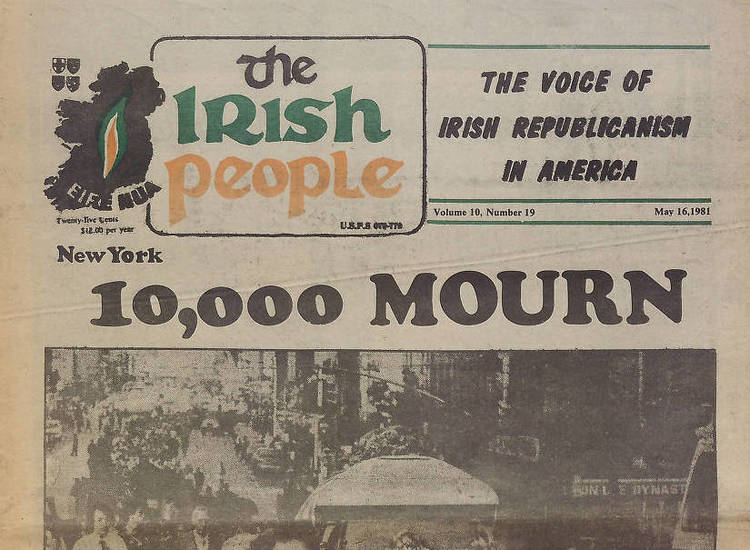Painting of the Battle of Germantown by Italian artist Xavier della Gatta that St. George helped to create in 1782 to reflect on St. George’s participation in those battles. The paintings are in the Museum of the American Revolution’s permanent collection.
By Matthew Skic
On Sept. 28, the Museum of the American Revolution in Philadelphia debuted its newest special exhibition, “Cost of Revolution: The Life and Death of an Irish Soldier,” which is all about the entangled histories of the American Revolution of 1776 and the Irish Revolution of 1798. However, it tells the story of the transatlantic impact of the American Revolution in a way you might not expect: through the eyes of an artistic Irish officer in the British army who opposed both revolutions.
Richard St. George is the primary character in “Cost of Revolution,” on display until March 17, 2020, in the Museum’s 5,000 square-foot special exhibitions gallery. St. George is likely someone you’ve never heard of. His name can be found in few history books of the American Revolution and the Irish Revolution. Yet, this member of the Irish Protestant landed gentry in County Galway lived a fascinating, dramatic, and tragic life. For someone who wasn’t a statesman, a nobleman, or a high-ranking military officer, St. George’s life is one of the most visually rich stories of the Revolutionary era.

Virginia Rifleman. Harlan Crow Library. One of Richard St. George’s personal sketches from the American Revolutionary War, on loan from a private collection.
Born in around 1752, St. George became a published cartoonist as a young man. His cartoons, 10 of which were published in London in 1772 and 1773, poked fun at the “macaroni” fashions of British men. St. George joined the British Army in 1775 and shipped off to America in 1776 to fight against the “rebels” who threatened the British Empire’s stability. Before he left, St. George commissioned a large portrait of himself in his scarlet British officer’s uniform by Thomas Gainsborough. At the time, little did he know that the war in America would dramatically change his life.
In America, Richard St. George fought in some of the largest and most violent battles of the Revolutionary War: Long Island, Fort Washington, Brandywine, Germantown. A fellow officer, Martin Hunter, described his aggressiveness in battle, calling him “military mad.” Hunter also remembered that St. George continued to draw caricatures on campaign. Four of St. George’s cartoons from the American war survive, and each one has its own satirical title, similar to his earlier London cartoons. One titled “My Triumphant entry into Philadelphia” refers to the bloody head wound that St. George suffered at the Battle of Germantown in 1777, which halted his military career and nearly took his life. For the rest of his days, St. George wore a silver plate in his skull installed during the head operation he survived in Philadelphia.

Officer’s Fusil. Museum of the American Revolution. Richard St. George and other British officers who served in America often carried fusils, like this one, that they purchased. A fusil and bayonet provided an officer with a more practical weapon for fighting in wooded country against sharpshooting riflemen than the cumbersome spontoon (tall spear).
St. George returned to Ireland as a wounded veteran, traumatically effected by war. He sought out ways to deal with his constant head pain, delirium, and hallucinations. He befriended artists and poets who helped him cope with his troubles. St. George even traveled to Italy to seek out a warmer climate to recover and worked with Xavier della Gatta, a painter in Naples, to paint scenes of the battles of Paoli and Germantown, two battles that profoundly affected St. George. Those two paintings, part of the Museum of the American Revolution’s collection, partially inspired this exhibition.
The 1790s brought more changes to St. George’s life and to Ireland. St. George’s wife tragically passed away in 1792, four years after their wedding. At the same time, revolution was rising to new levels of violence in France. The French Revolution, combined with the ideals of the American Revolution, inspired a generation of Irish Revolutionaries, led by the United Irishmen, to fight for Irish independence from the British Empire and rights for all Irishmen, including the Catholic majority of the population. In 1798, the United Irishmen would launch their revolt that ultimately did not succeed. At the beginning of the bloody year, Richard St. George stood in opposition to the United Irishmen. His tenants in County Cork rose up and assassinated him. News of St. George’s spread like wildfire in the Irish press. He was one of roughly 30,000 Irish men, women, and children who lost their lives during the Irish Revolution of 1798.

Dog collar (1773). Museum of the American Revolution. A redcoat’s canine friend wore this brass collar. It is engraved for Daniel Munroe, the dog’s owner, who served with the 43rd Regiment in Boston. It is on loan from Don Troiani.
Based on decades of historical detective work and new discoveries made by the Museum’s curators, “Cost of Revolution” exhibits the 22 surviving works of art, now spread out across the globe, that Richard St. George is known to have posed for, created, or helped create. Brought together for the very first time, this art documents a 20-year period in St. George’s life in which he fought against two revolutions—one in America and another in Ireland—losing his health and ultimately his life in the process.
[caption id="attachment_104221" align="alignnone" width="191"]
The Museum of the American Revolution has partnered with Ireland’s national cultural institutions, such as the National Gallery, National Library, National Museum, and the Ulster Museum, to bring art and artifacts from Ireland’s 18th century revolutionary history to America for the very first time. Highlights include Theobald Wolfe Tone’s bloodstained pocketbook from 1798, three portraits of St. George painted by Irish artist Hugh Douglas Hamilton, Henry Joy McCracken’s green coat worn at the Battle of Antrim, and a shamrock decorated flag carried by the Irish Volunteers. These works of art and artifacts bring the cost of revolution to life.
For more information on “Cost of Revolution: The Life and Death of an Irish Soldier,” visit the Museum’s website: www.amrevmuseum.org.
Matthew Skic is associate curator of the Museum of the American Revolution.









